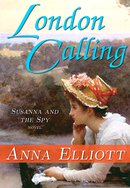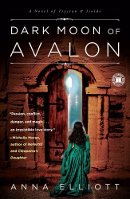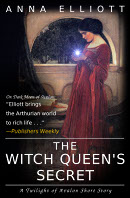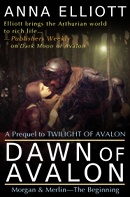Twilight of Avalon
FAQs
- The story you tell of Tystan and Isolde is very different from the one most people have read. Why is that?
- Which source for the Arthurian legend did you use in writing Twilight of Avalon?
- What research did you do?
- How much of Twilight of Avalon is based on fact, and how much is fiction?
- Would there really have been a castle at Tintagel in the early sixth century?
- How authentic are the herbal cures Isolde uses? Do you personally have any medical/herbalist experience?
- "How much of Isolde's story is autobiography?
- Has your conception of the trilogy changed since you started writing Twilight of Avalon?
- Do you have any personal experience with ESP/"the Sight"?
| Q. | The story you tell of Tystan and Isolde is very different from the one most people have read. Why is that? |
| A. |
The Arthurian legends as we know them today, with their knights in shining armor, jousts, tournaments, and the tragic love story of Lancelot and Gwenevere, are very much products of a later Medieval courtly chivalric world. But Arthur, if he existed at all, would have been a 5th-century British warlord, a far cry from the king of Camelot as he appears in the tales. The 5th century was a brutal, chaotic time in Britain. Roman Britain had crumbled; Rome's legions had been withdrawn from this far-flung outpost of the empire, leaving the country prey to invading Pictish and Irish tribes from the west and north and to Saxon invasions from the east. It was in many ways also a crucible in which the British identity and sense of place was forged and formed. And it is against this backdrop that Arthur appears, a war hero who led--or at least may have led--a victorious campaign against the invaders, driving them back for perhaps the space of a man's lifetime and so inspiring the roots of a legend that still captures our imaginations today.
I was fascinated by this possibility of a real King Arthur, and fascinated by the world in which he might have lived. So I decided to set my story there, to make my particular Arthurian world a blend of the earliest versions I could find of the legends and what scraps of historical fact we know of Dark Age Britain. As one of the later additions to the Arthurian cycle of tales, the legend of Trystan and Isolde is particularly grounded in a later Medieval, chivalric world, with its tragic love triangle that echoes the more famous Arthur-Gwenevere-Lancelot one. And in many ways, also, the story becomes a bit of a Christian morality play. (Which to be honest I think is a disservice to the characters of Trystan and Isolde, whom I loved from my first encounter with them). And yet the Trystan and Isolde story, like the Arthur one, has its roots in earlier legends and traditions. As I was doing research, I started to wonder what those earliest traditions might have been, what the story might have looked like at its first inception during the chaos and violence of Dark Age Britain, the "real" Arthurian age. Twilight of Avalon is my attempt to create a story that both fit my Dark Age setting and might credibly have been told and retold, adapted and changed through the ages to eventually become the Trystan and Isolde story as we know it today. I loved having the framework of the original story as a foundation on which to build, but at the same time I was fairly free in my adaptation of the legend in terms of letting myself tell the story I wanted to--that felt very important to me. After all, these stories have been around for centuries, told and retold countless times. How could I justify yet another re-telling unless my version added something new to the mix? |
| Q. | Which source for the Arthurian legend did you use in writing Twilight of Avalon? |
| A. |
Twilight of Avalon's version of the King Arthur legend is roughly based on Geoffrey of Monmouth's (probably largely fictional) account in his History of the Kings of Britain. Probably the most striking difference between Geoffrey's version and the legend as we know it today is the absence of the Gwenevere-Lancelot-Arthur love triangle. Lancelot, in fact, is not present at all, and it is Modred, Arthur's nephew, who betrays Arthur with Gwenevere. Below is a brief passage from Geoffrey of Monmouth on Modred's treason:
When summer came, [Arthur] made ready to set out for Rome, and was already beginning to make his way through the mountains when the news was brought to him that his nephew Mordred, in whose care he had left Britain, had placed the crown upon his own head. What is more, this treacherous tyrant was living adulterously and out of wedlock with Queen Guinevere, who had broken the vows of her earlier marriage. I also based the character of Morgan, Arthur's sister, on Geoffrey of Monmouth's version of the Arthur tales. Below is the passage from Geoffrey's Vita Merlini which was the spring board for my conception of Morgan: [Avalon] is the place where nine sisters administer genial rule over those who come to them from our homelands, and the first of them is the more learned in the art of healing, and her beauty exceeds that of her sisters. Her name is Morgan and she had learned what the use is of every kind of plant in curing the weaknesses of the body. She also knows the art of changing her appearance and of flying, like Daedalus, through the air on curious wings. As she wills it, she can be at Brest or at Chartres or at Pavia; and as she wills, she comes from the skies to your shores. |
| Q. | What research did you do? |
| A. |
I tried to read all the Arthurian primary sources. Geoffrey of Monmouth's History of the Kings of Britain was the version of the story I'd decided to use as the basis for my book, so of course I read and re-read that, as well as Nennius' Historia Brittonum, another early source of Arthur material. I read the early Welsh Arthurian tales like Culhwch and Olwen and The Dream of Rhonabwy, as well as the later medieval legends like Le Morte d'Arthur. And then I also read both the Anglo Saxon Chronicle and Gildas' De Excidio et Conquestu Britanniae, neither of which mention Arthur, but which give a picture of the political climate in sixth-century Britain. (That being the age in which scholars agree a historical Arthur might have existed, it was also the period in which I'd decided to set my story). And of course I also read all the available versions of the original Trystan and Isolde story.
I also read every book I could get my hands on about Dark Age Britain in general, and the possibility of a historical Arthur in particular. It definitely helped that I live in a university town and have access to a great research library! Since I'd decided to make Tintagel Castle in Cornwall the setting for Twilight of Avalon, I also studied the archaeological work that's been done at the site. It's a fascinating place. The Arthurian connection has been largely discounted by scholars as mere literary invention. But the latest archaeological work has suggested that there was at least some kind of a princely fortress there during the 5th/6th centuries, which would have been contemporary with King Arthur's (if he did in fact exist) time. And then I pretty much had an enormous pile of research books on my desk throughout the writing process that I would constantly refer to as I worked. I would often need to double check a date or a place name or other historical reference, or look at pictures of Cornwall to refresh my mental image of the landscape I was writing about. And all the herbal medicine that Isolde uses meant a lot of research during the writing process, as well, looking through early herbals and medical tracts to find cures that would have been known and used in 6th-century Britain. |
| Q. | How much of Twilight of Avalon is based on fact, and how much is fiction? |
| A. |
While I was doing research for Twilight of Avalon, I read several fascinating books that explore the possibility of a real-life historic Arthur. But it really is only that--a possibility. Very, very little can be discovered or said with any certainty about who the man himself might have been. And at the same time, although I'd decided to set my story far from the legendary Camelot at a time a real Arthur might have lived, I felt as though there were certain conventions of the later Arthur legends that I wanted to pay tribute to and honor.
I decided to base my Arthur on one of the earliest tellings of the Arthur story: that recounted by Geoffrey of Monmouth in his History of the Kings of Britain, written in the mid twelfth-century. In this version, the now famous Gwenevere-Lancelot-Arthur love triangle does not exist; in fact, Lancelot is not yet even present as one of Arthur’s fighting men. Instead, it is Modred, Arthur’s heir, who betrays the king by seizing both Gwenevere and the throne. I used this version of the story as the backdrop for Twilight of Avalon and at the same time tried to place it in a world that was as authentic as possible a representation of what Dark Age Britain might have been. The historical basis for the characters of Trystan and Marche is even more scant than that for a historical Arthur: the single true piece of evidence for their existence is a memorial stone in Cornwall with the inscription: Drustans hic iacet Cunomori filius, which means, “Drustanus lies here, the son of Cunomorus.” Many scholars have plausibly suggested that the characters referred to are the Tristan and King Mark of later medeival tales, Drustanus being a recognized variant of the name Tristan (or Trystan) and Cunomorus being the Latinized version of the name Cynvawr, who is identified by the ninth-century historian Nennias with King Mark (or March or Marche). In terms of the other characters, I used the names of the Saxon kings who would likely have been ruling the kingdoms of Kent and Wessex at the time, and my Madoc of Gwynedd is based on the historical sixth-century King Maelgwn Gwynedd, who was indeed a leading king of the age and whom the 6th-century historian Gildas identifies as "Dragon of the Isle." Myrddin (Merlin) may indeed have been a famed Welsh Bard. Apart from these, though, Twilight of Avalon’s Britain is a a blending of legend and truth, an attempt to portray the historical world of sixth-century Cornwall, while still honoring the legends that are, after centuries of telling and re-telling, as real as historical fact. |
| Q. | Would there really have been a castle at Tintagel in the early sixth century? |
| A. |
I'm afraid Twilight of Avalon's great stone fortress at Tintagel is pretty much purely anachronistic. Recent archaeology suggests that there was some sort of important fortification there during the 5th century--one belonging to a powerful Dark Age chieftan, to judge from the remnants of expensive imported wine jugs that have been found. But that the site ever had the remotest connection to Arthur is unlikely in the extreme. And certainly that Dark Age chieftan's fortress would not have resembled anything in the nature a castle as we think of such places today. One of the challenges of the writer of Arthurian fiction is to balance historical fact with legend. I did try to make my Arthurian world as close to an accurate portrayal of early 6th-century Britain as I could. But at the same time, as I mentioned above, there were elements of the King Arthur legend that are so much a part of the Arthurian world and the Arthurian canon that they felt as real to me--and as worth honoring--as historical fact. One of those elements was a brooding, majestic castle perched on the crumbling edge of Cornwall where the land meets the sea--and where Arthur, son of Uther the Pendragon, was conceived and born. An authentic Dark Age wattle and daub and thatch dwelling just didn't feel the same to me. |
| Q. | How authentic are the herbal cures Isolde uses? Do you personally have any medical/herbalist experience? |
| A. |
Very little concrete information about Dark Age medicine has survived, but I used a variety of period herbals (books of herbal cures) as resources to find remedies that Isolde might credibly have used. Probably my favorite resource was a wonderful book called Medicinal Plants in Folk Tradition: an Ethnobotany of Britain and Ireland by David E. Allen and Gabrielle Hatfield, which catalogues the various medicinal uses of most plants native to Britain and Ireland and details the geographic areas where each remedy was most commonly found.
In terms of my own experience with healing arts, I know only what I learned through reading and research. I've never tried any of the herbal cures Isolde uses myself--so I make no guarantees about how effective they would be in practice!--and certainly I would have no idea whatsoever how to stitch a wound or set a broken bone. When I was small I wanted to be a doctor and/or nurse, so I loved that I got to learn about it and live it a bit through Isolde's eyes. But in real life, pretty much the closest I ever come to being a "healer" is giving my little girl a dose of baby Tylenol when she's teething. |
| Q. | How much of Isolde's story is autobiography? |
| A. | Really, none. None whatsoever. I suppose in some ways Isolde is like me as a person--it's one of those truisms of a writer's craft that the characters you create are all inevitably aspects of yourself. But in terms of her life experiences and the trials she's faced, I really was relying solely on research and imagination. Some of the issues in Twilight of Avalon--sexual violence and the grief of losing a child, to name just two--are obviously weighty ones. And I wanted to do my best to honor anyone who has lived through those trials by making Isolde's emotional response to them as real as I possibly could. I read many accounts written by survivors of sexual violence, talked to people, read articles and books about grief and loss and healing and did my best combining what I read with what I knew about Isolde to make her journey as authentic as possible. |
| Q. | Has your conception of the trilogy changed since you started writing Twilight of Avalon? |
| A. | I've certainly gotten to know my characters--Trystan and Isolde in particular--on a deeper level as I spend more time with them and watch them grow through each book. But my conception of the trilogy and the fundamental plan I've had for the progression of the three books has remained essentially the same. I actually wrote the final scene of the third and final book (working title, Sunrise of Avalon) before I typed a single line of Twilight of Avalon, so I've always been writing with that ultimate goal in mind. |
| Q. | Do you have any personal experience with ESP/"the Sight"? |
| A. | I have had--very, very rarely--what are probably the most boring instances of precognition in the history of all extra-sensory phenomenon. Like, once I had a dream that my neighbor stopped me in our driveway and asked if I could collect her mail and papers, as she was going to be away for a few days. And the very next morning, she did just that--exactly like in my dream. Things like that. (Sorry--I did warn you it was boring!) |













